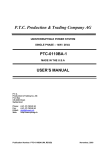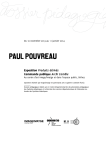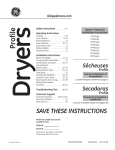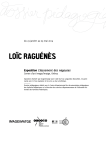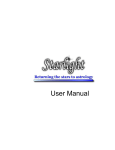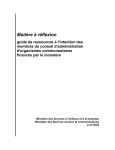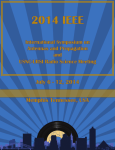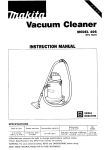Download A User's Guide - Australian Libraries Copyright Committee
Transcript
A User’s Guide to the Flexible Dealing Provision for Libraries, Educational Institutions and Cultural Institutions Section 200AB of the Copyright Act 1968 (Cth) 1 Published by the Australian Libraries Copyright Committee and the Australian Digital Alliance with the assistance of the National Library of Australia, 2008. Text by Laura Simes. This work is licensed under a Creative Commons Attribution-Noncommercial-Share Alike 2.5 Australia. To view a copy of this licence, visit creativecommons.org/licenses/by-nc-sa/2.5/au/ or send a letter to Creative Commons Australia, c/- Law Faculty, Queensland University of Technology, GPO Box 2434, Brisbane Qld 4001 Australia. Australian Digital Alliance TheADAisanon-profitcoalitionofpublicand private-sector interests formed to promote balanced copyright law and provide an effective voice for a public interest perspective in the copyright debate. ADA members include universities, schools, galleries, museums, ICT companies and other research organisations, libraries and individuals. For further information on our objectives and the work we do, visit www.digital.org.au/. PO Box E202, Kingston ACT 2604, Australia T: 02 6262 1273 F: 02 6273 2545 ABN: 91 256 931 758 Australian Libraries Copyright Committee The ALCC is the main consultative body and policy forum for the discussion of copyright issues affecting Australian libraries and archives. It is a cross-sectoral committee with representatives from national and state libraries and archives, as well as peak library and archive bodies. For further information on our objectives and the work we do, visit www.digital.org.au/alcc/. PO Box E202, Kingston ACT 2604, Australia 02 6262 1273 F: 02 6273 2545 ABN: 51 611 768 743 T: 2 Contents Acknowledgments ii 1 Purpose and Nature of This Guide 1 2 Background to Section 200AB 3 Overview of Copyright Law 3 Copyright Amendment Act 2006 4 The Flexible Dealing Provision 4 3 Steps to Take When Deciding to Use the Flexible Dealing Provision 7 There Are No Other Exceptions Available to You The Purpose of the Use 10 9 The Use Is Non-commercial 12 The Use Will Not Conflict with Normal Exploitation 13 The Use Will Not Unreasonably Prejudice the Copyright Holder 14 The Use Is a Special Case 15 4 Scenarios 17 Libraries 18 Archives and Collecting Institutions 29 Educational Institutions 34 Copying for People with a Disability 37 5 Our Patented Flexible Dealing Cheat Sheet 39 6 Further References 41 7 Section 200AB of the Copyright Act 1968 43 i Acknowledgments Thanks to members of the Australian Libraries Copyright Committee, Australian Digital Alliance, Copyright in Cultural Institutions, and Australian Library and Information Association Intellectual Property Advisory Committee; staff of the National Library of Australia; Delia Browne from the Copyright Advisory Group of the Ministerial Council on Employment, Education, Training and Youth Affairs; and Sarah Waladan from Minter Ellison for thoughts and comments as this guide was compiled. Particular thanks go to Moyra McAllister, Paul Dalgleish, Bronwyn Dowdall, Ian McDonald, Kimberlee Weatherall and Robyn Wright for detailed feedback of draft copies of the guide. Thanks also to the attendees of the 2007 Australian Libraries Copyright Committee copyright sessions, whose questions and examples are the basis of many of the scenarios discussed in this guide. ii 1 Purpose and Nature of This Guide Section 200AB was introduced into Australian law through the Copyright Amendment Act 2006 (Cth) with the aim of providing a ‘flexible exception to enable copyright material to be used for certain socially beneficial purposes, while remaining consistent with Australia’s obligations under international copyright treaties’.1 Because section 200AB is an open-ended exception that uses terms drawn from international copyright treaties, some institutions may not be sure exactly how much use it allows. This publication therefore provides guidance and suggestions for institutions considering using section 200AB. The guide does not, and cannot, provide legal advice or advice tailored to your particular situation. If you need to know how the law applies to a certain situation, a copyright lawyer can advise you. A number of other guides to section 200AB exist, some of which are referred to at the end of this publication. For example, the Copyright Advisory Group has produced a guide and the Australian Copyright Council has published a fact sheet and a more detailed guide. There are differing views on a number of issues relating to section 200AB, and these are reflected in the different guides. Your organisation’s management or lawyers can advise you, particularly in situations where there are differing views on a matter. 1 Explanatory Memorandum, Copyright Amendment Bill 2006 (Cth), 108. 1 2 2 Background to Section 200AB Overview of Copyright Law Copyright law in Australia gives copyright holders exclusive rights to do certain things with their material. Depending on the type of material, the copyright holder generally has the right to control: »» publication »» performance »» communication to the public »» adaptation of the material (for example, a translation or adaptation from a novel to a play) »» reproduction. If a person or institution wishes to use material under copyright in a way that can be controlled by the copyright holder (for example, making a copy), they will generally need to seek the permission of the copyright holder. Material is protected by copyright for up to 70 years after the death of the creator. Works that have been unpublished can remain in copyright in perpetuity. These rights provide copyright holders with an incentive to produce works, as they are given a time period during which they can exploit the work for their own economic gain. However, it is recognised that copyright law must strike a balance between providing this incentive to create and providing users (and creators) of copyright material with reasonable access. It is particularly important that copyright law is not so restrictive that it hinders people and institutions from using copyright material for socially beneficial purposes, such as education and research. For this reason, the Copyright Act 1968 (Cth) contains a number of exceptions to copyright holders’ rights. Where an exception applies, the individual or institution does not need to obtain the permission of the copyright holder before they use the material, and in many cases, will not need to pay a fee or royalty. Most exceptions under Australian copyright law are quite specific in nature. That is, they only apply to certain types of uses or purposes. For example, the ‘fair dealing’ exceptions apply only to uses such as criticism and review, reporting the news, research and study, and parody and satire. There are also exceptions that apply to certain organisations, for example libraries, and only to certain uses within libraries, such as copying for preservation purposes. For further information on copyright law in Australia, see ‘Further References’ on page 41. 3 Copyright Amendment Act 2006 The Copyright Amendment Act 2006 came into effect in December 2006, and among other things introduced new criminal provisions, provisions relating to digital locks (called ‘technological protection measures’), and a number of exceptions for users of copyright materials. Prior to this, the Attorney-General’s Department released an issues paper on copyright exceptions.2 Many user groups, including the Australian Digital Alliance and the Australian Libraries Copyright Committee, made submissions to the government in support of a flexible dealing provision, similar to the ‘fair use’ exception in the United States. However, the US exception is different from Australia’s in that it does not apply to specific purposes, specific types of uses and certain types of bodies or institutions. The US exception is a general provision available to any individual or body and involves balancing factors such as the way the material is used and the effect the use will have on the market for the copyright material. As it is a general provision, new or innovative uses (including new uses as technology changes), are possible under this doctrine provided the circumstances of the use are ‘fair’. The Flexible Dealing Provision The Copyright Amendment Act 2006 does not include a US-style ‘fair use’ provision, but does include section 200AB. This provision applies to libraries, archives and educational institutions, as well as people and institutions assisting those with a disability, and is intended to operate like fair use. As stated in the Explanatory Memorandum, section 200AB is intended to be a ‘flexible exception’ that allows use of copyright material for ‘certain socially useful purposes’.3 The Attorney-General’s Department also states in its fact sheet that this provision should allow use of copyright material for ‘“special” purposes that benefit the broader Australian community’. This flexible dealing provision will be particularly helpful to institutions in cases where their proposed use of copyright material falls outside other specific exceptions, such as fair dealing or library and archives preservation provisions. Very briefly, the requirements for using the flexible dealing provision are: »» no other exceptions apply »» the use is for a certain purpose (more information on this is provided later) »» the use is non-commercial »» the use will not prejudice the copyright holder »» the use will not compete with, or take profit from, the copyright holder »» the use is a special case. 2 Attorney-General’s Department, Copyright Fair Use and Other Copyright Exceptions. Canberra: Attorney-General’s Department, 2005, www.ag.gov.au/www/agd/agd.nsf/Page/Publications_Copyright-ReviewofFairUseExeption-May2005. 3 Explanatory Memorandum, Copyright Amendment Bill 2006 (Cth), 109. 4 The final three requirements are known as the ‘three-step test’. This test has been directly imported from international treaties such as the Agreement on Trade-related Aspects of Intellectual Property Rights (TRIPS). The three-step test is the threshold that domestic governments (who are signatories to TRIPS) need to apply when introducing exceptions to copyright to ensure compliance with international law. Although there are a few steps to satisfy before making use of this provision, it is important to remember that the purpose of the provision is to make it possible for institutions to use copyright material for a range of socially beneficial purposes, and it is to operate in a flexible way. Other exceptions under the Copyright Act only deal with a narrow range of specific situations and uses, therefore preventing the use of the copyright material even though it would not have a detrimental effect on the copyright holder and would be beneficial to society. These kinds of uses are possible under the flexible dealing provision. Some common areas where section 200AB will be able to help libraries, archives, galleries and educational institutions are: »» format-shifting »» use of orphan works (works whose copyright holders cannot be identified or located) »» digitisation »» adapting works to assist with educational instruction, to assist in the operation of a library or archives, or to produce a more accessible copy of the work. 5 6 3 Steps to Take When Deciding to Use the Flexible Dealing Provision Below is a flowchart summarising the steps to take when deciding to use section 200AB. An explanation of each step follows. You might find this section useful to refer to when making your own decisions and as examples are discussed in ‘Scenarios’ on page 17. There are no other exceptions available to you You are using the material for a set purpose The use is non-commercial The use does not conflict with normal exploitation The use will not unreasonably prejudice the copyright holder The use is a special case Use allowed under the flexible dealing provision 7 What Material Is Covered? All types of copyright material are included. This includes artistic works such as paintings, photographs, diagrams and architectural plans; musical works such as compositions; literary works such as novels, poems and newspaper articles; and dramatic works such as plays. It also includes other types of copyright materials such as films, recordings and broadcasts. These materials can be in any format, including hardcopy and digital. What Do We Mean by ‘Use’? The ‘use’ of the material can be any act that would otherwise constitute an infringement. Most commonly, this would be copying the material but it also includes uses such as making an adaptation, performing the material or using a substantial part of the work to create something else. The Australian Copyright Council holds the view that when assessing whether you can use material under the flexible dealing provision, you need to define the use so that it takes into account a possible change of circumstances in the future. For example, if a DVD that you format-shifted from VHS may become commercially available, you need to define your ‘use’ so that once it is available commercially, you discard the DVD copy made under section 200AB. We do not share the view that section 200AB places an onus on you to ‘re-check’ periodically whether any of the factors might have changed. We believe that you need only look at matters as they stand at the time you rely on section 200AB. Once you have legitimately made the copy under section 200AB, there will be no requirement for you to destroy it in the future. However, should you wish to make a new use of your section 200AB copy (for example, place it online), then at that time you would need to check if section 200AB allows you to do this. We take this view because, unlike some other exceptions in the Copyright Act (for example, the private copying exceptions), section 200AB does not contain any ‘backward-looking’ qualification to suggest that if circumstances change, the copy becomes illegal. We understand the Copyright Advisory Group also holds this view. Technological Protection Measures Technological protection measures are digital locks placed on electronic material to prevent people from copying, or even accessing, it. Examples of technological protection measures are DVD copy-protection and access codes. It is an offence to break (‘circumvent’) these locks. However, there are some exceptions that allow people and institutions to break the locks in certain cases. For example, libraries can break a digital lock to make preservation copies of the material. However, the Copyright Act does not allow digital locks to be broken (or circumvented) in order to use section 200AB. This means you cannot rely on this flexible dealing provision (section 200AB) if your intended use requires you to break the digital lock. For example, if you wish to make a copy of a DVD that contains copy protection, it will be an offence to break the lock. 8 However, the Attorney-General has the power under the Copyright Act to authorise the breaking of digital locks in certain circumstances. If you have identified an act you think would be allowed under section 200AB but you need to break a lock, you can apply to the Attorney-General’s Department for this use to be prescribed (and so made legal). Declarations and Record Keeping Some other exceptions under the Copyright Act include record-keeping requirements (for example, the Part VB statutory licence and the document delivery/interlibrary loans provisions). Some also require declarations to be made before copying or another use can occur. There are no record-keeping requirements under section 200AB. However, your institution may have its own procedures regarding record keeping and may decide (as a matter of good practice) to keep a record of when and why section 200AB has been relied on. This is a matter for you and your institution to resolve. There Are No Other Exceptions Available to You The Explanatory Memorandum for this part of the flexible dealing provision states: This condition ensures other specific exceptions and statutory licences continue to apply and are not overtaken by s 200AB. Eg, where an act is permitted under a statutory licence, a user cannot access s 200AB as a way of avoiding the obligation to pay remuneration by failing to meet a condition of the statutory licence.4 For this step, you need to check if there is another exception you can rely on for your proposed use: »» Can you rely on a fair dealing exception, for example, fair dealing for the purpose of research or study, reporting the news, or parody and satire? »» Libraries or archives: can you use one of the specific exceptions, for example, a preservation provision such as section 51A, which allows libraries to make copies of works for preservation purposes? Or can you rely on the interlibrary loans and document delivery provisions? »» Educational institutions: does the intended use fall under one of the statutory licences, that is, Part VA or Part VB licences? These licences cover many uses. Educational institutions should also check whether the use is permitted under an exception such as section 28, which allows performance and communication of works in the course of educational instruction. 4 Explanatory Memorandum, Copyright Amendment Bill 2006 (Cth), 112. 9 »» Some institutions such as libraries in government departments or government archives may be able to rely on the Crown copying provisions under section 183. This is a statutory licence that allows expansive use of materials but is remunerable, as under the Part VA and Part VB licences. If your institution can rely on this provision for the proposed use, then section 200AB will not be available. »» If you are assisting a person with a disability and you are an educational institution, check that the Part VB licence dealing with assistance for people with a print disability does not apply. The Purpose of the Use There are three possible purposes of use under the flexible dealing provision. If you work at a library in an educational institution, it may be possible to rely on either the library purpose or the educational institution purpose. Any institution can also utilise this provision to assist a person with a disability. Library or Archives If you work at a library or archives you should be using the material for the purpose of maintaining or operating the library or archives. »» This includes providing a service of a kind usually provided by a library or archives. »» It also includes activities designed to maintain the current collection and, arguably, activities designed to keep the collection up to date. »» It encompasses both the internal administration of the library or archives and providing services to users. This is a broad-purpose test that includes the full ambit of usual library and archives activity. It includes ‘usual’ services, but can also include activities such as a new service offered by the library (noting of course that you still have to pass the other steps). The use can also be by or on behalf of the library or archives, so the institution can have another person or organisation act as agent for them. For example, if a library wished to shift material from VHS to DVD format relying on the flexible dealing provision, but did not have the technical capacity to do so, the library could engage another organisation to do the format-shifting on its behalf. Educational Institutions If you are an educational institution you should be using the material for the purpose of educational instruction. The Explanatory Memorandum for this part of the provision states that this includes classroom and remote teaching.5 5 10 Explanatory Memorandum, Copyright Amendment Bill 2006 (Cth), 110. The term ‘educational instruction’ is not used restrictively and can include a range of activities such as: »» preparing to teach »» compiling resources for students »» assessing and examining »» anything else that is for the purpose of teaching. As with libraries and archives, the use can be by or on behalf of the educational institution, so the institution can get another person or organisation to act as agent for it. Use by or for a Person with a Disability The flexible dealing provision can be used by, or to assist, a person with a disability that results in difficulty in reading, viewing or hearing the material in its current format. A person with a disability can take advantage of this provision, along with any other person or institution (including educational institutions, libraries and cultural institutions). Those using this provision just need to make sure that the reason for their use of the copyright work (adapting, making large-text copies, adding subtitles, etc.) is to provide a person with a disability with material in a new form, or with a feature that reduces the difficulty caused by the disability. Note, however, that educational institutions have other exceptions for assisting people with a disability that may restrict the ability to rely on section 200AB. Definitions Library There is no definition of ‘library’ in the Copyright Act. Where terms are not defined, the practice is to look to the ordinary meaning of the word (including dictionary definitions). The term ‘library’ would no doubt include a collection of books, journals and other materials (including audiovisual and electronic materials) that is maintained for research, study and reference by users. Archives ‘Archives’ is defined in the Copyright Act. It specifically refers to the National Archives of Australia and state archives bodies in New South Wales, Victoria and Tasmania. The general definition includes any collection of documents or other materials provided they are of historical significance or public interest. The body needs to be maintaining and preserving the documents, and cannot be doing it for the purpose of making a profit. The Act specifically states that museums and galleries could have collections that fall under this definition. 11 Educational Institution An ‘educational institution’ is defined in the Copyright Act and includes a wide range of bodies: »» pre-schools or kindergartens »» primary schools »» secondary schools »» universities »» technical and further education (TAFE) institutions »» other organisations offering education. This includes bodies offering external study or correspondence, and schools of nursing. For further information, see section 10 of the Copyright Act or seek legal advice. The Use Is Non-commercial The exact phrase used in section 200AB is that the use cannot be ‘partly for the purpose of commercial advantage or profit’. In practice, this means you cannot use the flexible dealing provision if the use is partly or wholly for the purpose of commercial advantage or profit. The provision specifically states it is acceptable to charge a cost-recovery fee. You need to think about the reason for using this provision. If you are using it to make a profit or to obtain a commercial advantage over competitors, then you will probably run into difficulties. You will not have problems if you are using the material for a non-commercial purpose. Commercial entities such as profit-making colleges may have more difficulty dealing with this requirement. We do not think that just being a commercial entity excludes the use of section 200AB, however these bodies may need to seek further advice on the extent to which reliance on section 200AB is possible. If you are not sure whether you are using the material for profit or commercial advantage, it may be useful to ask: »» Is the use linked to the purpose (for example, offering a library service) or is it more closely linked to an activity in which a commercial entity might be engaged? »» Are you selling something, or using the material in connection with the sale of a good or service, for a price that is greater than cost recovery? Whether an activity is ‘partly for the purpose of commercial advantage or profit’ is an issue on which different views have been expressed, and one on which your institution may have taken (or may need to take) a position. 12 The Use Will Not Conflict with Normal Exploitation This step is about assessing how your use affects the way copyright holders usually make money from their copyright material. The Explanatory Memorandum states: The questions to be considered under this condition are whether the use closes off ways that copyright holders normally extract economic value from copyright in the Australian market or enters into economic competition with those ways, thereby depriving copyright holders of significant or tangible commercial gains. Forms of exploitation which, with a certain degree of likelihood, could acquire considerable economic or practical importance may also be considered.6 The sorts of questions you can ask here are: »» How does the copyright holder usually make money from their copyright material? »» Will your proposed use enter into competition with the copyright holder’s use? »» Will your proposed use deprive the copyright holder of significant or tangible commercial gains? »» How might the copyright holder want to make money from their copyright material in the near future? Is it likely that your use would deprive the copyright holder of future economic gains? ‘Normal Exploitation’ You need to assess whether the way you want to use the material is a use that a copyright holder normally charges for. The types of licences that would be considered ‘normal exploitation’ would be those that copyright holders commonly use to exploit their works, such as those offered for the performance of a play or music, or to copy materials such as hymns for a church or sheet music for an orchestra. There are differences of opinion on exactly what assessment section 200AB requires an institution to perform in relation to ‘normal exploitation’. The Australian Copyright Council, for example, states that an institution needs to consider not just the immediate impact of the particular use, but ‘whether your use, if done by every person entitled to rely on section 200AB, would deprive copyright holders [generally] of significant or tangible gains’.7 It can also be argued that the references in section 200AB to the copyright work require a more specific consideration of the impact of conflict with a particular copyright holder’s normal exploitation. The Act is unclear. In any event, it is probably best not to assume that ‘one little use doesn’t hurt anyone’, and in the case of a significant amount of use, to seek advice. These issues will also be relevant to analysing the risk of relying on section 200AB. 6 7 Explanatory Memorandum, Copyright Amendment Bill 2006 (Cth), 110. Australian Copyright Council, Special Case Exception: Education, Libraries, Collection. Sydney: Australian Copyright Council, 2007, at 9. 13 Some examples of situations where it is likely your use will conflict with the copyright holder include: »» if you are using the material to make an adaptation/reproduction/new format that will be available for sale »» if there is a common licence that you could obtain for the intended use. Some situations where it is likely that your use will not conflict with the copyright holder include: »» if you cannot purchase the adaptation/reproduction/new format of the material »» if the material you wish to use has been abandoned by the copyright holder (and so they are clearly not exploiting nor intending to exploit the material) »» if the material is something that the copyright holder never had an intention of exploiting commercially and which they still do not wish to exploit commercially »» if there is no common licence for what you want to do. A collecting society might inform you it does not have a standard licence for the use, but it can put together a new or one-off licence. This is not a ‘normal’ licence and so would not be part of the ‘normal exploitation’ of the material, particularly if your use is new or novel, or one for which collecting societies have not normally offered a licence. The Use Will Not Unreasonably Prejudice the Copyright Holder As stated in the Explanatory Memorandum, the use must not: unreasonably prejudice the legitimate interests of the holder of the copyright or a person licensed by the holder of the copyright. This condition requires an assessment of the legitimate economic and non-economic interests of the copyright holder.8 The previous step involved thinking about how the copyright holder usually makes money from their copyright material. This step involves thinking about the way you intend to use the copyright material, and how your use might affect the economic and non-economic interests of the copyright holder more generally. This is not just about whether your use will interfere with the copyright holder’s profits—it is also about whether it will interfere with their other interests. It is also about making sure that you use the copyright material in a fair and reasonable way that will not unnecessarily interfere with the copyright holder’s rights. You can tackle this step by asking these kinds of questions: »» Am I using the material in an appropriate way, for example, am I making sure I only make as many copies as necessary? »» Am I respecting the moral rights of the creator, for example, have I properly attributed them (if possible)? 8 14 Explanatory Memorandum, Copyright Amendment Bill 2006 (Cth), 110. »» Have I made any changes to the work? If so, are they necessary and is it obvious on the copies that there have been changes? »» Am I thinking about other issues such as privacy, whether the work is published or not, and cultural sensitivities? »» Will my use of the material expose it to possible misuse, for example piracy, or have I placed appropriate controls on the use, for example, by restricting access? Remember that the issue is whether you are unreasonably prejudicing the copyright holder. In many cases, your use of the material will prejudice the copyright holder to some extent. This step is about making sure that you limit your use so that your prejudice is not unreasonable. Examples of actions you might take to limit the use are: »» attaching conditions to the use »» restricting who has access to the material, for example, password protection »» using compressed-format or low-resolution copies »» making sure, if reasonable and practicable, copies have information about the copyright holder attached »» using only as much of the material that you need. The Use Is a Special Case If you have proceeded through all the other steps, it is very likely that your use is a special case. That is, this hurdle should not be too difficult to satisfy. The Explanatory Memorandum for section 200AB states this step is ‘intended to ensure that the use is narrow in a quantitative as well as qualitative sense’.9 In order to do this, section 200AB requires you to consider all the other steps, and in the context of these steps, decide if the use is special. At this step you will be checking that your intended use is narrow, specific and identified. If you have gone through all the previous steps and made appropriate adjustments to your use accordingly (for example, using only how much you need or limiting access online through password protection), once you get to this final step it is very likely that you will already have modified your use in a way that ensures it is appropriately narrow. When you look at this step: »» Check that you have passed the other steps. At each of these steps, if necessary, you should have narrowed or modified your use so that prejudice to the copyright holder is limited, you are not interfering with the copyright holder’s economic interest, your use is non-commercial and so on. »» Check that you have an identifiable reason for the use, that is, that you are not making copies or using the material speculatively or ‘just in case’. Once again, it is likely that you will have identified an appropriate need or reason for the use at the purpose test (that is, when checking the purpose is for maintaining or operating the library, for educational instruction, etc.). 9 Explanatory Memorandum, Copyright Amendment Bill 2006 (Cth), 110. 15 16 4 Scenarios This section provides a number of possible scenarios where the flexible dealing provision might be useful. Many of these scenarios are real-life situations provided by our members. This is not an exhaustive list. As this is a flexible dealing provision, it would be impossible (not to mention quite tedious) to outline every possible use. However, looking at these worked examples will give you a good idea of issues to think about and questions to ask when deciding to use the provision. You will find that both the Copyright Advisory Group and the Australian Copyright Council have more scenarios in their guides. Some examples are worked through in detail, while others just outline a few issues that the scenario raises. You will see in these examples that the flexible dealing provision has a very broad application, and that often you just need to moderate your use a little so that it fits within the provision. When starting with a very broad possible use, you will find that as you run it through each step it will naturally become more defined and discrete. For example, if you propose to provide access to your library’s collection online (a very broad use), the step where you check the use does not conflict with normal exploitation will exclude digitisation of publications such as Harry Potter, but will most likely allow orphan work ephemera. When you get to the step where you limit prejudice to the copyright holder, you may decide that some unpublished and more sensitive materials will be digitised but only made available to people who request access (for example, researchers). This guide does not constitute legal advice. If you need to know how the law applies to a particular situation, you may need to seek formal legal advice. 17 Libraries A public library has a room where users can borrow programs, documentaries and films from the library’s collection and watch them. It has a documentary on VHS but no longer has video players on the premises. It wishes to shift this from VHS to DVD format. Yes. The library can use the flexible dealing provision for this use, subject to some issues outlined below. We have also discussed some variations in this use and how this might affect the availability of the flexible dealing provision. There is no other exception. If the reason for wanting to format-shift the VHS documentary is because it is damaged or deteriorating, then the library could use section 110(2)(b), which allows a replacement copy to be made for preservation purposes. However, in this scenario the reason behind wanting to format-shift is technological obsolescence, so there is no other exception the library could use. For the purpose of maintaining or operating the library. It is quite common for libraries to offer a room where users can view films or documentaries held in its collection. The use is non-commercial. In this scenario, the library’s use of the copyright material is non-commercial as the service would be offered to users free. If the library decided to charge per view of the documentary, and this fee exceeded the cost of providing the service, then this step would not be satisfied. The use does not conflict with normal exploitation. At this step the library would look at the availability of the documentary in DVD format. If the library contacted the distributor and discovered that it currently sells the same documentary in DVD format, then by making its own DVD copy the library would be coming into conflict with how the copyright holder normally makes money from their work. The library may also be aware that the distributor will soon be issuing the documentary on DVD. This might raise problems, but would not necessarily prevent the library from making its own copy. For example, if the reason for format-shifting the documentary was because a user had requested to view it, it would be irrelevant that the DVD would soon be available. That is, if there is a need for the documentary to be available in DVD format within a certain timeframe, the library could format-shift it themself. 18 The use will not unreasonably prejudice the copyright holder. At this step the library can think about the way it intends to use the documentary, and how to make sure that the use respects the copyright holder. For example, the library should make sure the format-shifted copy replicates attribution details on the original (for example, the creator, date of publication and distributor). The library should also check it is using the material only to the extent it needs to. For example, if the library holds only one copy in VHS format, it is probably reasonable to make only one copy rather than multiple copies. The use is a special case. Here, the library thinks about the factors discussed in the previous steps to decide if the use seems special in the circumstances. In its current format, the documentary is useless due to technological obsolescence and there is no other provision to allow the library to format-shift. The library has ensured the use is limited by only format-shifting one equivalent copy. A public library has a special collection that is intended to strengthen Indigenous people’s English and information literacies. The library wants to translate popular children’s stories into local languages and produce in-house bilingual versions of these stories. Items in this collection are free and available to all but not for loan. Yes. The library can use the flexible dealing provision for this purpose. There is no other exception. Copyright holders have the right to control adaptations of their work, so to make these translations, the library needs an exception or permission from the copyright holder. There are no exceptions that apply, so the flexible dealing provision is open to them. For the purpose of maintaining or operating the library. This step is worded broadly to include any use for the purpose of operating the library. The Explanatory Memorandum for this step states that this encompasses providing services to users. The library’s intended use in this case is clearly a service offered to users. The use is non-commercial. The library has no problems at this step. An example of a use that would not comply with this step would be if the library decided to commercially produce these translated stories. The use does not conflict with normal exploitation. The library would only have problems satisfying this step if: »» the copyright holders offered translations in the local languages for sale (then the library would be denying copyright holders their profits) 19 »» the copyright holders commonly receive income through licences for this type of adaptation/translation. If in doubt about whether the copyright holder commonly offers a licence, the library could contact the copyright holder or publisher for further information. The use will not unreasonably prejudice the copyright holder. In this example, the library has already proposed taking a number of measures that will minimise any prejudice to the copyright holder. It will not be charging any money, and is confining access to the materials to the library’s premises. The library could also make sure it includes proper attribution on the translated versions (for example, author, artist or original publisher details). The use is a special case. Considering the earlier steps and the scenario, this looks to be a special case: it is a non-commercial, socially beneficial activity that would not be possible under other exceptions. The library has also clearly taken steps to ensure the use of the material is appropriately limited. A librarian receives a reference query from a user on a particular subject. The librarian responding to the query would like to send the user an article that is available from a subscription service that the library pays for. Maybe. The librarian may also be able to rely on a different exception. There is no other exception. The librarian could provide the user with the article reference and recommend they request the article for research and study under the document delivery provisions (sections 49 and 50 of the Copyright Act). However, these document delivery provisions can only be used to provide material for the user’s research and study. If the use falls outside sections 49 and 50, the librarian could arguably use the flexible dealing provision to supply the material. The use is non-commercial. The library has no problems with this step. It could even charge users on a cost-recovery basis if necessary, but would not be able to charge full commercial rates in an attempt to make a profit from these materials. The use does not conflict with normal exploitation. To ensure this step is satisfied, the librarian can check if the article on its own is available for sale. If it is readily available to purchase, the librarian may then be coming into conflict with how the copyright holder makes a profit if they provide the article free. 20 Some collecting societies take the view that neither section 200AB nor the fair dealing defences apply in these circumstances.10 We take the view that in the majority of cases at the moment there will be no conflict with normal exploitation of copyright material. The use will not unreasonably prejudice the copyright holder. The librarian can take simple steps and limiting measures to ensure the copyright holder will not be prejudiced. They could provide full citation details, or provide electronic material in a format that minimises reader misuse of the material. For example, it could be provided via a web link that will expire after a short period. The use is a special case. In this scenario, the librarian has looked at the other steps and has decided each one has been satisfied. The way the material will be used has been appropriately moderated and limited. The librarian may also need to check the terms and conditions of the subscription service, as these may prevent certain uses. A user makes a request to a library for a copy of audio or audiovisual material for the purpose of research and study. Can the librarian make a copy for them? Yes. After conducting some checks and limiting the use appropriately, in certain cases the librarian can copy the material. There is no other exception. The library document delivery provisions (sections 49 and 50) allow libraries to provide certain materials for research and study, but this does not include audiovisual material. There are no other exceptions on which the library could rely. For the purpose of maintaining or operating the library. A common function of libraries is to supply users with access to their resources, so this use certainly falls within this step. The use is non-commercial. The library will satisfy this step by only charging cost-recovery fees (or not charging at all). The use does not conflict with normal exploitation. The library should check whether the material requested is available for purchase, including as a download. 10 Australian Copyright Council, Special Case Exception: Education, Libraries, Collections. Sydney: Australian Copyright Council, 2007, at 30. 21 If the material is rare, difficult to obtain or no longer sold by the distributor, then providing the material would not be interfering with the copyright holder’s normal method of exploiting the material. It is likely that in most cases, audiovisual material would only be available for purchase in full (if available at all). If the whole film is available for purchase but the user only wants a small portion of the audiovisual material, then it is likely that providing this small portion would not conflict with normal exploitation. The use will not unreasonably prejudice the copyright holder. The library could address moral rights issues by including proper attribution in the copy. Another measure for making sure prejudice to the copyright holder is kept to a minimum is only copying the required quantity/extract for the user. If providing material electronically, the library might decide to stream the file, rather than offer it as a download, to minimise misuse by others. The use is a special case. At this point, the library has gone through all the earlier steps, decided it is satisfied, and made modifications to what amount of material is provided and how. The use has been limited appropriately, or as the Explanatory Memorandum says, in a ‘qualitative and quantitative sense’. As mentioned on page 8, section 200AB cannot be used if it involves breaking a digital lock. This will prevent, for example, use of copy-protected DVDs. A public library wishes to make preservation copies of items in its collection. Probably not under this provision. There are a number of other exceptions available to the library that would allow the copies to be made. The library could possibly use this provision if the type of preservation did not fall under the other exceptions. There is no other exception. Sections 51A and 110B allow libraries and archives to copy works for preservation purposes. If the material is already published, the library must first check if it is available commercially for a reasonable price. The material must be damaged or deteriorated before the library can use these sections. 22 The library may want to make preservation copies to proactively preserve the material (that is, it does not want it to become damaged before it is preserved). Once again, there is another exception that could apply. The key cultural institution provisions (sections 51B, 110BA and 112AA) allow preservation copying before actual damage has occurred. This provision automatically applies to state and national libraries and archives. Other organisations can apply to the AttorneyGeneral to be prescribed as a key cultural institution. They would then be able to make preservation copies. For further information on these provisions, see the Australian Digital Alliance/Australian Libraries Copyright Committee information sheet at www.digital.org.au/documents/Key_cultural_institutions.pdf. However, there may still be situations where the library wishes to make preservation copies and other provisions are not available. In these cases, the library can work through the steps and make any necessary modifications to the intended preservation actions to bring the use under the flexible dealing provision. A library wishes to make preservation copies of born digital material in its collection. The digital material is commercially available online but the library wants to make preservation copies of the material to ensure that it continues to be available in the future (for example, even after the material has been taken off the original web page). Yes. The flexible dealing provision allows the library to make preservation copies of born digital material. There is no other exception. The preservation provisions would not apply in this scenario as these provisions require the material to be commercially unavailable (that is, the material cannot be obtained ‘within a reasonable time, at an ordinary commercial price’). The use does not conflict with normal exploitation. The material in this scenario might include, for example, online articles that can only be accessed through a subscription. If the library proposed to make its preservation copies available to the public at the same time that the articles were available on a subscription basis, this would clearly conflict with the normal exploitation of the material. However, in this scenario, the library is not proposing to make the preservation copies generally available, so there would not appear to be any conflict with normal exploitation. 23 If the library later wished to make the preservation copies available online to the public (when the articles were no longer commercially available), it may be able to do this under section 200AB, but would need to work through the steps again. The use will not unreasonably prejudice the copyright holder. The library has attempted to limit prejudice to the copyright holder by ensuring the preservation copies are not made available to the public. Information such as author and copyright holder details are also preserved in the new copies. There should be few problems satisfying this step. The library may also need to check if there are terms and conditions associated with the born digital material, as these may restrict certain uses. A university library has a specialist collection of USSR material (for example, anonymous political pamphlets), and wishes to make it available electronically. The library plans to limit access to the material to three people at any one time. It will only be available online (off the premises) to people using the material for research and study, and who have declared they will not use the material for a commercial purpose. A substantial quantity of the material is orphan works. Yes. The university library is likely to be able to do this for a large quantity of the collection, but should look at the items in detail to check that particular problems will not arise at certain section 200AB steps. There is no other exception. A library can make material available online for researchers at its premises if it is material that was copied under sections 51A and 110B (preservation provisions). These provisions are probably not helpful in this case as they only allow preservation copies to be made of manuscripts and first recordings. In the case of other materials, they must first be damaged, deteriorated, lost or stolen before the library can make preservation copies. For the purpose of maintaining or operating the library. This is a university library. However, the proposed action relates to library activities rather than educational activities, so it is the library purpose that needs to be satisfied. The purpose—making material more readily available to researchers and library users—easily satisfies this step. 24 The use does not conflict with normal exploitation. In this scenario, most of the materials are orphan works, that is, the copyright holder is unknown or it is difficult or impossible to locate them. In many cases involving orphan works, this step will be easily satisfied. Often the work has not been commercially exploited by the copyright holder, and will not be in the future as there was never any commercial intention behind the work (for example, former USSR government pamphlets or other ephemera). It would be prudent for the library to look at the material in detail to check there are no individual items that are of commercial value, and which may raise a possible conflict with normal exploitation. For example, if the collection contained a piece by a well-known Russian author, the library might have to take further steps to ensure the use did not conflict. The use will not unreasonably prejudice the copyright holder. Even when the copyright holder is unknown, the library should still take some steps to ensure the copyright material is used appropriately. In this example, use of the material will be fairly restricted and only available outside the library for research and study, after the users declare the material will not be used for a commercial purpose. The university library may even be restricting the use more than necessary. For example, the library could certainly allow access for other fair dealing purposes, such as reporting the news. It could even consider allowing access to anyone, provided users agree they will not use the material for infringing purposes. The use is a special case. Considering all the steps, this appears to be a special case. The library has proposed to take a number of measures to limit how the material can be accessed and used. This case seems particularly ‘special’ given the materials are orphan works, and could not be used at all since permission of the copyright holder could not be obtained. A library wishes to digitise works to allow public access to parts of the collection that are not stored onsite. The public will be able to access the works through computers onsite or via the internet. Maybe. Whether the library can do this will depend on the material. In some cases, the library will be able to use the flexible dealing provision, but if the material is still commercially available it would not be possible. The use does not conflict with normal exploitation. This is quite an expansive scenario, making it difficult to provide an answer that applies to all the material. It is quite likely that some of the works the library intends to digitise are commercially available. This may include availability in a digital 25 format. If the library digitised and made this material available to the public, this would very likely conflict with the way that the copyright holder normally obtains revenue from the work. On the other hand, the library collection probably includes rare and out-of-print material that would be very difficult for library users to access, let alone purchase. It will often be the case that the copyright holder is no longer commercially exploiting the material. The library should check if the material is soon to be reprinted, as this could cause a conflict between freely available material on the internet and the reprinted books available for sale. Scenarios such as this are worded very broadly and potentially include a diverse range of materials and circumstances. In order to deal with each of these steps sufficiently, we recommend breaking the scenario into smaller ‘chunks’. It may even be advisable to, for example, check whether any individual items might soon be reprinted or otherwise made commercially available in a way that would conflict with the intended use. A library in a law firm wishes to scan the headings and outlines of articles in a periodical to alert staff to new acquisitions. Yes. There is no problem with a library reproducing contents pages containing information such as headings, page references and citations, as this information would either not be protected by copyright or would most likely be an insubstantial amount. Other material on contents pages, such as outlines, images or graphs, will be works protected by copyright and this may be an area where the flexible dealing provision will be helpful. For the purpose of maintaining or operating the library. This proposed use is a common service provided by libraries. The use does not conflict with normal exploitation. It is unlikely that a copyright holder of the material in a contents page would consider it a ‘normal’ part of their income stream to receive either direct payment, or payment in the form of royalties, from this material. 26 Can the library make a replacement DVD cover if the first one was damaged? Yes. However, the library can make this replacement copy under a different exception—section 51A. Section 51A allows the library to make a replacement copy of a published work if it has been damaged, deteriorated, lost or stolen, after first checking whether the work is commercially available. In this case, the published work is the DVD cover itself. Since individual DVD covers are not available for purchase, the library could rely on section 51A to make a replacement copy. Can a library scan the front cover of a book to include in a library newsletter? The purpose is to let users know about new books available to borrow. Yes. In some cases, the cover itself will not even be protected by copyright, for example, if only the author’s name and title are included, or where the cover is an out-of-copyright artwork. However, if the cover contains original artwork it will attract copyright protection. In this case, the library could rely on a fair dealing exception (for the purpose of reporting the news) and will probably not need to rely on section 200AB. No other exception applies. Section 42(1) provides a fair dealing exception that allows use of a work for the purpose of reporting the news. As the book cover is being used as part of an article in a newsletter, provided proper acknowledgment is given and the use is a ‘fair dealing’, there is no need to seek reliance on section 200AB. 27 A library receives electronic images of book covers from its suppliers during the centralised purchasing process to aid in online selection. Can public libraries use these images in their own online catalogues to publicise their holdings to users looking for particular items? Maybe. As noted in an earlier scenario, in some cases the book covers will not be covered by copyright. In other cases, the library might be able to rely on the flexible dealing provision. The library should also check whether there are terms and conditions attached to the image supplied, as these may expressly prevent the library from using the images in this way (and would result in a breach of contract). The use does not conflict with normal exploitation. There are differing views on this issue. Some suppliers provide thumbnail book cover images at a cost to customers. However, it is unclear whether these customers are paying for a licence to use the images or just paying for the convenience of the digital thumbnails. It may be that as many of these companies are US based, they are not providing a licence for libraries because use of the thumbnails seems to come under US ‘fair use’. From our research, it does not seem as though licensing of book cover images is a normal way that a copyright holder obtains money. The use will not unreasonably prejudice the copyright holder. As always, the library should think about limiting the use of the images by only including lowresolution images (thumbnails) on its catalogue. By reproducing the images this way, they will be of little value or use to others, thereby minimising the chances that they will be used for infringing purposes. 28 Archives and Collecting Institutions An archives is able to rely on the Crown copying provision (section 183). What scope is there for using the flexible dealing provision? There is still wide scope for use of section 200AB. These types of bodies will be able to use the flexible dealing provision when they are not copying ‘for the service of the Commonwealth or a State’. There is no other exception. The flexible dealing provision is not available when other exceptions can be used. This includes the Crown copying statutory licence under section 183. Bodies that are copying ‘for the service of the Commonwealth or a State’ can rely on section 183 for any copies they make. This kind of copying is usually administered by the Copyright Agency Limited, with payment made to the agency, which then distributes it to the copyright holders. However, if the material is not to be used ‘for the service of the Commonwealth or a State’, the archives can work through the steps and decide in each case whether the use can occur under the flexible dealing provision. There is no hard and fast definition of section 183 and what it covers. Institutions relying on section 183 that have an agreement with the Copyright Agency Limited could check what kind of copying is covered under the agreement. Often section 183 will cover things such as copying material to compile reports or use of material for certain types of training, but will not cover activities such as copying material from a collection for internal use or external research. It is unlikely that galleries and museums in their day-to-day activities will rely on section 183, whereas the activities of a library within a government department are more likely to fall under section 183. Staff may need to seek advice from their institution to find out what kinds of uses fall under section 183. A state gallery is planning an exhibition of a special collection. It wishes to include promotional thumbnail images and compressed-format audio from the collection on its website. Yes. Provided the gallery takes appropriate limiting steps, the flexible dealing provision will be available for orphan works and possibly other works. 29 For the purpose of maintaining or operating the archives. As mentioned earlier, a gallery’s collection falls under the definition of an ‘archives’ in the Copyright Act. However, if the gallery in this scenario was run for profit, it would not fall under the definition and could not rely on the flexible dealing provision. Making material available to the public is one of the core operations of a gallery. This proposed use would be part of the operation of the archives, as promotion informs users and the public about current collection displays and exhibitions, and also allows people in remote areas to experience the collection. The use is non-commercial. This step could raise issues if, for example, the gallery was charging users to access the recordings and images on its site. The use does not conflict with normal exploitation. In the case of orphan works (for example, where the gallery does not know or cannot find the copyright holder), it will often be the case that the material is not being exploited by the copyright holder. Therefore, there will not be problems with conflict with the copyright holder’s usual revenue stream. If the copyright holder is known? ‘Normal exploitation’ is a difficult term to pin down. It is not going to cover absolutely every use that a copyright holder or their representative (for example, a collecting society), might decide to draw revenue from. That is, this step is about ensuring your use does not conflict with common ways that copyright holders obtain revenue for their work. Licence fees for thumbnail images are currently not a normal way in which copyright holders obtain revenue, so the gallery would not be depriving the copyright holders of significant commercial gains. The question to ask is whether the use will affect ways that copyright holders normally extract economic value in the market. The Viscopy website offers licences for the purchase of high-resolution copies of images and for the purchase of reproduction rights of images. We do not believe these licences conflict with making a low-resolution copy for display on a gallery’s website. Other organisations, such as the Australian Copyright Council, hold a different view on this issue. The use will not unreasonably prejudice the copyright holder. In this scenario, the gallery is taking steps to limit prejudice. By using low-resolution images and streamed or compressed audio on the website, it is limiting the chances of the material being copied for illegal purposes, as their quality would make them useless for most infringing activities. The use is a special case. It is socially beneficial for the gallery to be able to promote items in its collection to the public. By taking the limiting measures discussed in the other steps, the gallery is making sure the use is appropriately limited in scope. 30 An art gallery is planning an exhibition and wants to include a copy of an unpublished orphan work in a pamphlet to promote it. Yes. Provided the gallery takes appropriate precautions, this use comes under the flexible dealing provision. There is no other exception. If dealing with an unpublished orphan work, the gallery could check that the special exception allowing publication of unidentified materials does not apply.11 If the orphan work is less than 50 years old, this exception could not be used, so the flexible dealing provision would be available. The use is non-commercial. The gallery may have problems if the intention is to run a profit-making exhibition. It is acceptable to charge a cost-recovery fee, but if the gallery is making a profit from the exhibition, it is likely that this step would not be satisfied. The use does not conflict with normal exploitation. The questions to think about are whether the gallery’s use will enter into competition with the copyright holder’s use or deprive them of significant commercial gains. Since this is an orphan work, it appears that the copyright holder is not exploiting the work at all. In most cases of orphan work material, such as old letters or papers, there will be little or no commercial value. The gallery will be able to conclude that the copyright holder is not commercially exploiting the material, and will not seek to do so in the future. The use will not unreasonably prejudice the copyright holder. This is an important step when dealing with orphan works. It will often be easy to satisfy the previous step, as an orphan work will rarely be commercially exploited now or in the future. At this step, however, even though the copyright holder is unknown, it is still important for the gallery to consider how they would want the material to be used. If the unpublished orphan work contains material of a personal nature, or sensitive Indigenous material, the gallery should be wary about publishing this content. Even though the gallery does not know who the copyright holder is, it should respect their moral rights. Although attribution may not be possible, the gallery could place a notice about the work nearby, stating that it has tried to locate the copyright holder and provide contact details so a claimed copyright holder can approach the gallery. 11 Section 34, Copyright Act 1968 (Cth). 31 This is a special case. This use fits within the category of ‘special case’. The material is an orphan work and the gallery cannot locate the current copyright holder to obtain permission to use it. The use is quite limited—it will be reproduced in a pamphlet, so will be a fairly low-quality reproduction. The gallery does not intend to make any money out of the use, and it does not appear that the copyright holder (wherever they are) intends or desires to commercially exploit the work. A municipal council has a small local history museum. The museum has its own catalogue that has only been used internally. Some of the records include a link to a scanned version of a photograph or an image of an object. Most of the photographs date back to the nineteenth century, but some are quite recent. The museum wishes to import this catalogue into the library’s service catalogue so it is available for people to access and search online. Yes. This will be possible for some, and perhaps all, of the images. The use will not unreasonably prejudice the copyright holder. In this scenario, the council will be including the images alongside the records, so attribution of the copyright holder (where known) will not be a problem. The council can limit the possibility of others misusing copyright images by only providing them as thumbnails. The use does not conflict with normal exploitation. As mentioned in an earlier scenario, in the case of orphan work, the material is not usually being exploited by the copyright holder at all, so there will be no conflict with the council’s proposed use. The situation is more uncertain where the copyright holder is known. In certain circumstances, reproducing images in a catalogue would not interfere with the way copyright holders usually exploit their works. If the local council only uses thumbnail reproductions, we do not believe this use would conflict with the way that a copyright holder normally exploits their works. However, Viscopy offers licences for high-resolution electronic copies and we understand that it considers any electronic reproduction of images as conflicting with this licence. 32 An archives wants to feature unpublished documents (non-government sources) from its collection on the educational section of its website. The document authors, while identified by the documents, are otherwise unknown and untraceable. Can the archives place digital copies online? Yes. The flexible dealing provision can be relied on in this case. The use does not conflict with normal exploitation. In this scenario, it seems unlikely that the material is being exploited at all, so this step should pose no hurdle. The use will not unreasonably prejudice the copyright holder. Even though the copyright holder cannot be located, the archives can still take steps to minimise prejudice. In this case, this might include a notice (or hyperlink) advising readers that the copyright holder could not be located, and setting out a policy for the prompt take-down of material where the copyright holder comes forward and does not want the material available online. This is a special case. The proposed use is specific and identified, as it involves digitisation of a small set of documents whose copyright holders cannot be located. It appears to be an appropriate special case. 33 Educational Institutions A teacher wishes to put together a DVD compilation of excerpts from films to show in a lecture. Yes. The flexible dealing provision can be relied on in this case. There is no other exception. Educational institutions should first check whether the use is covered under Part VA or Part VB statutory licences (administered by Screenrights and the Copyright Agency Limited, respectively). In this scenario, the teacher proposes to use material from a film that is not covered under either of the licences. If the material was to be compiled from a television program rather than a film, then the Part VA licence would cover the use. For the purpose of educational instruction. The proposed use certainly fits within this purpose. The use is non-commercial. This use would not be considered commercial in any way. The use does not conflict with normal exploitation. It would not be possible to purchase the exact compilation required for the class. There are also no licences offered for compilation of film extracts in this way, so this use will not compete with the normal exploitation of the films. The use will not unreasonably prejudice the copyright holder. In this scenario, the teacher’s proposed use of the copyright material is already quite narrow, as they are only making one copy and will only be using short extracts from the films. There would therefore be no problem with prejudice to the copyright holder. This use is a special case. As noted, the teacher is limiting their use of the material, and their reasons for the use of the material align with the educational instruction purpose. The ‘special case’ requirement seems to be met. As mentioned on page 8, section 200AB cannot be used if it involves breaking a digital lock. This will prevent, for example, use of copy-protected DVDs. 34 A classroom only has a DVD player. A teacher therefore wishes to format-shift a film from VHS to DVD format to show to the class. Yes. The flexible dealing provision is available after checking whether the film is available to purchase as a DVD. The use does not conflict with normal exploitation. It is this step that the teacher will need to consider most carefully before deciding to format-shift the film. If the film is currently available in DVD format, then format-shifting the film would enter into competition with a common type of commercial exploitation (that is, re-issuing material in DVD format). The teacher may also want to check whether the film will be released in DVD format in the near future. However if the film will not be available in DVD format in the appropriate timeframe, the teacher could still format-shift it for the class. The use will not unreasonably prejudice the copyright holder. As the teacher will only be showing the film in class, there is little possibility of prejudice to the copyright holder. For example, the teacher is not exposing the film to a situation where it could be copied or used for infringing purposes. We assume the teacher will also provide appropriate details about the film to the class. The use is a special case. This use of copyright material is quite narrow and for a set purpose. We believe all the other steps have been satisfied and appropriately limited, for example, the teacher is not lending out the DVD, which could open the work up to infringement. This scenario appears to be a ‘special case’ under this provision. A lecturer finds a podcast that is freely available on the internet and relevant to the class. They wish to copy the podcast and make it available to students in an online learning environment, for example, Blackboard or WebCT. Yes. The flexible dealing provision is available in certain cases. An alternative to relying on section 200AB would be to simply provide a web link to the podcast. There is no other exception. The Part VA licence covers use of broadcasts, so if the podcast was taken from an ABC broadcast, for example, the Part VA licence could be relied on. 35 The use will not unreasonably prejudice the copyright holder. The lecturer will be making the podcast available in a restricted environment, and one would assume with appropriate attribution, thereby minimising any prejudice to the copyright holder. The use does not conflict with normal exploitation. If the podcast has been made freely available on a website, it would not appear the copyright holder intends to commercially exploit it. There should therefore be no commercial conflict in reproducing the podcast for students. However, it would be prudent for the lecturer to check if there are restrictions under the terms and conditions of the originating website. Another issue for the lecturer to consider is that although the podcast is free, the copyright holder may obtain commercial benefit through advertisements on the site. In this case, copying the podcast to an online environment could interfere with revenue obtained through visits to the website. A music teacher wishes to make their lecture available to students as a podcast, however part of the lecture involves the teacher playing an excerpt of music to the class. Can the teacher do this? Yes. The flexible dealing provision can be used in this case. There is no other exception. The statutory licences do not cover this scenario, and the section 28 exception does not allow copies to be made of performances within a class. The use does not conflict with normal exploitation. This use of a small extract of music in a podcast is not covered by any common licence and would not be available for purchase, so there would be no conflict with normal exploitation of the material. The use will not unreasonably prejudice the copyright holder. In this scenario, there does not appear to be any unreasonable prejudice since only a small extract is being reproduced and the podcast will only be available to students. For more examples of educational uses, see the Copyright Advisory Group’s information sheets at the Smartcopying website: »» http://smartcopying.edu.au/scw/go/pid/542 »» http://smartcopying.edu.au/scw/go/pid/533. 36 Copying for People with a Disability A teacher wishes to caption a television episode that will be shown in class to assist a student with a hearing impairment. Yes. This use is possible under the flexible dealing provision. There is no other exception. No exception would allow this use. The Part VB licence for educational institutions allows for some types of accessible copies but this does not include captioning. In order to assist a person with a disability in reading, viewing or hearing the work or for the purpose of educational instruction. In this scenario, the use satisfies both of these purpose tests. If the person making the captions was not a teacher, but an organisation or a friend, they would rely on this specific disability purpose. The use does not conflict with normal exploitation. To make sure the teacher’s use will not be in conflict, they should check whether it is possible to buy a captioned version of the program. If none is available, or it will not be available in time for the class, the teacher can be confident this step is satisfied. A person with a vision impairment asks their university to convert music (written notation) into Braille format. Yes. This use would be possible under the flexible dealing provision. There is no other exception. The Part VB licence allows educational institutions to make copies to assist people with a disability, but this is not included. In order to assist a person with a disability in reading, viewing or hearing the work. The scenario fits within this purpose. The use is non-commercial. The person in this scenario is not prevented from going to a commercial organisation to obtain a copy in a more accessible format. However, the organisation can only charge a cost-recovery fee for this service. The use does not conflict with normal exploitation. Before going ahead with this use, the person should first check whether the music is available for purchase in Braille format. 37 38 5 Our Patented Flexible Dealing Cheat Sheet There are no other exceptions available to you. Consider whether other exceptions apply to the use, such as: »» fair dealing provisions »» library provisions »» statutory licences (for example, Part VA and Part VB licences or the Crown copying provision under section 183). You are using the material for a set purpose. Libraries and archives In order to maintain or operate the library or archives. »» Includes providing a service of a kind usually provided by a library or archives »» Encompasses both the internal administration of the library or archives and providing services to users »» A broad purpose test that includes the full ambit of usual library and archives activity. It includes ‘usual’ services but can also include activities such as a new service offered by the library. Educational institutions For educational instruction. »» A broadly worded purpose that can include the full ambit of activities for educational instruction »» Includes things such as using material for teaching, preparing to teach, or compiling resources for students’ education Assisting a person with a disability that results in difficulty reading, viewing or hearing the material. Any person or institution can make use of copyright material to allow the person to obtain the material in a format that reduces the difficulty caused by the disability (for example, changing the format to a read-aloud book or adding subtitles). 39 The use is non-commercial. The use is ‘not for commercial advantage or profit’, that is, you should not be using the material with the intention of making a profit. It includes entering into competition in a way that provides a commercial advantage over competitors. Charges for cost-recovery purposes are acceptable. The use does not conflict with normal exploitation. The use does not compete with the way a copyright holder normally exploits (or makes a profit from) their work. Check the use will not interfere with a common stream of revenue for the copyright holder (for example, revenue from sales or licences). In some cases, it might be clear that in the future the copyright holder will be commercially exploiting your type of use (for example, where a company is in the process of re-issuing all VHS products as DVDs). The use will not unreasonably prejudice the copyright holder. Make sure the material is: »» used in a way that respects the moral rights of the creator »» considers other issues such as Indigenous sensitivities and privacy »» take steps to minimise exposing the material to misuse and copyright infringement. The use is a special case. »» Is your use narrow, specific and identified? »» Have you passed the other steps? »» Have you gone through the previous steps and made adjustments as necessary? »» You have limited the quantity of material used, how you will use it, who can access it, etc.? »» If all other steps have been satisfied, it is very likely the use will fall within the ‘special case’ category. 40 6 Further References Australian Digital Alliance www.digital.org.au/ Contains recent news and contributions to current copyright issues, such as government reviews. Also includes the ADA Intellectual Property Wrap-up, which summarises recent copyright cases, new legislation and other issues. Australian Libraries Copyright Committee www.digital.org.au/alcc Contains recent news and the Australian Libraries Copyright Committee’s contributions to current copyright issues, such as government reviews. Resources page (includes guides to different aspects of copyright, with a libraries and archives focus): www.digital.org.au/alcc/resources/ Copyright Advisory Group’s Smartcopying website Information sheets: http://smartcopying.edu.au/ The information sheets are aimed at schools, however, there are also a number of general information sheets, including one that discusses the flexible dealing provision: http://smartcopying.edu.au/scw/go/pid/533 and http://smartcopying.edu.au/scw/ go/pid/542. Attorney-General’s Department General copyright information: www.ag.gov.au/www/agd/agd.nsf/Page/Copyright Fact sheets on the 2006 copyright amendments: www.ag.gov.au/www/agd/agd.nsf/ Page/Copyright_IssuesandReviews_CopyrightAmendmentAct2006-Factsheets Australian Copyright Council Publications: www.copyright.org.au/publications Information sheets: www.copyright.org.au/publications/infosheets.htm 41 42 7 Section 200AB of the Copyright Act 1968 200AB Use of works and other subject-matter for certain purposes (1) The copyright in a work or other subject-matter is not infringed by a use of the work or other subject-matter if all the following conditions exist: a) the circumstances of the use (including those described in paragraphs (b), (c) and (d)) amount to a special case; b) the use is covered by subsection (2), (3) or (4); c) the use does not conflict with a normal exploitation of the work or other subject-matter; d) the use does not unreasonably prejudice the legitimate interests of the owner of the copyright. Use by body administering library or archives (2) This subsection covers a use that: a) is made by or on behalf of the body administering a library or archives; and b) is made for the purpose of maintaining or operating the library or archives (including operating the library or archives to provide services of a kind usually provided by a library or archives); and c) is not made partly for the purpose of the body obtaining a commercial advantage or profit. Use by body administering educational institution (3) This subsection covers a use that: a) is made by or on behalf of a body administering an educational institution; and b) is made for the purpose of giving educational instruction; and c) is not made partly for the purpose of the body obtaining a commercial advantage or profit. 43 Use by or for person with a disability (4) This subsection covers a use that meets all the following conditions: a) the use is made by: i) a person with a disability that causes difficulty in reading, viewing or hearing the work or other subject-matter in a particular form; or ii) someone else; b) the use is made for the purpose of the person obtaining a reproduction or copy of the work or other subject-matter in another form, or with a feature, that reduces the difficulty; c) the use is not made partly for the purpose of obtaining a commercial advantage or profit. This section does not apply if under another provision the use does not, or might not, infringe copyright (6) Subsection (1) does not apply if, because of another provision of this Act: a) the use is not an infringement of copyright; or b) the use would not be an infringement of copyright assuming the conditions or requirements of that other provision were met. Example 1: Paragraph (a)—Without using an appliance adapted for producing multiple copies or an appliance that can produce copies by reprographic reproduction, a school teacher reproduces a literary work in the course of educational instruction. Under subsection 200(1), the reproduction is not an infringement of copyright in the work, so this section does not apply. Example 2: Paragraph (b)—A body administering an institution assisting persons with a print disability makes a Braille version of a published literary work. Under subsection 135ZP(2), making such a version does not infringe copyright in the work if certain conditions (relating to remuneration etc.) are met, so this section does not apply. Cost recovery not commercial advantage or profit 6A) The use does not fail to meet the condition in paragraph (2)(c), (3)(c) or (4)(c) merely because of the charging of a fee that: a) is connected with the use; and b) does not exceed the costs of the use to the charger of the fee. Definitions (7) In this section: conflict with a normal exploitation has the same meaning as in Article 13 of the TRIPS Agreement. special case has the same meaning as in Article 13 of the TRIPS Agreement. unreasonably prejudice the legitimate interests has the same meaning as in Article 13 of the TRIPS Agreement. use includes any act that would infringe copyright apart from this section. 44 47 48























































